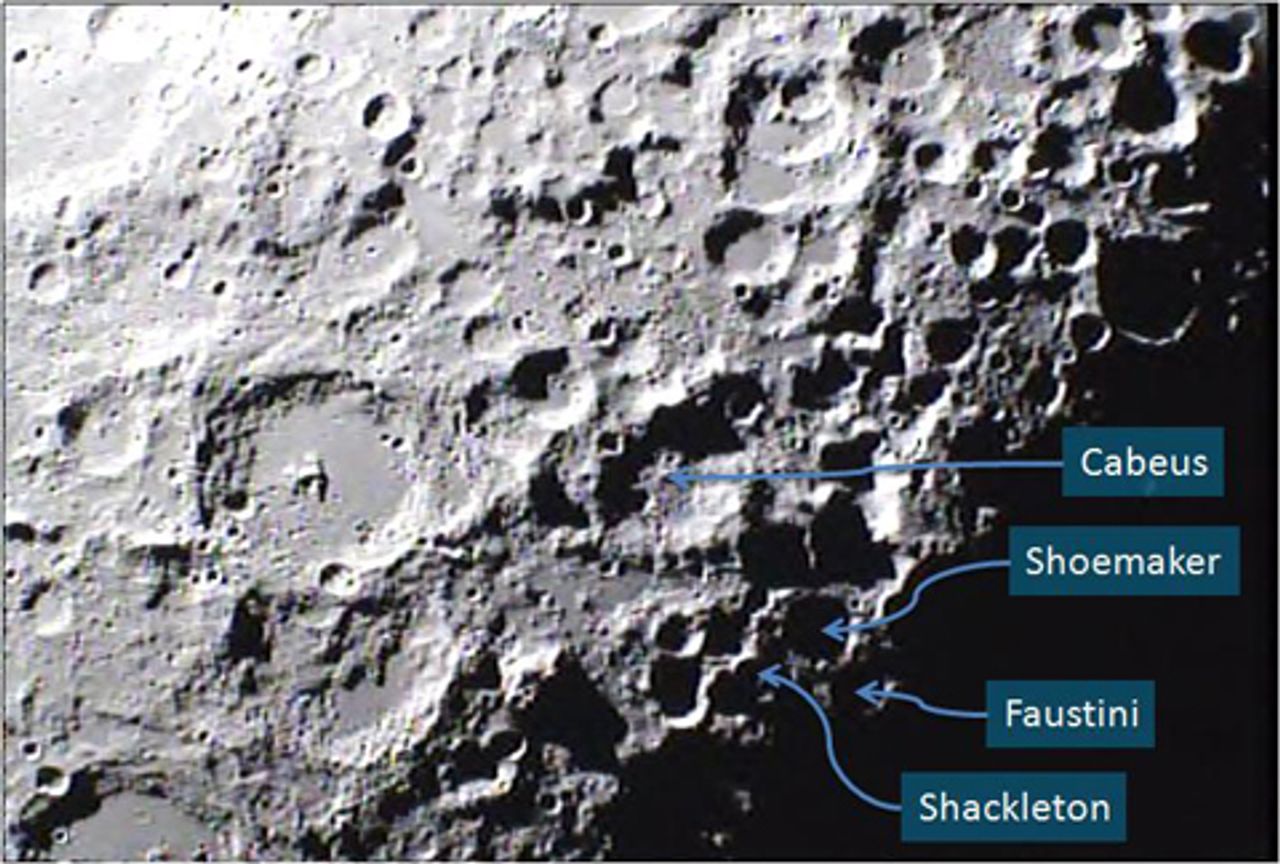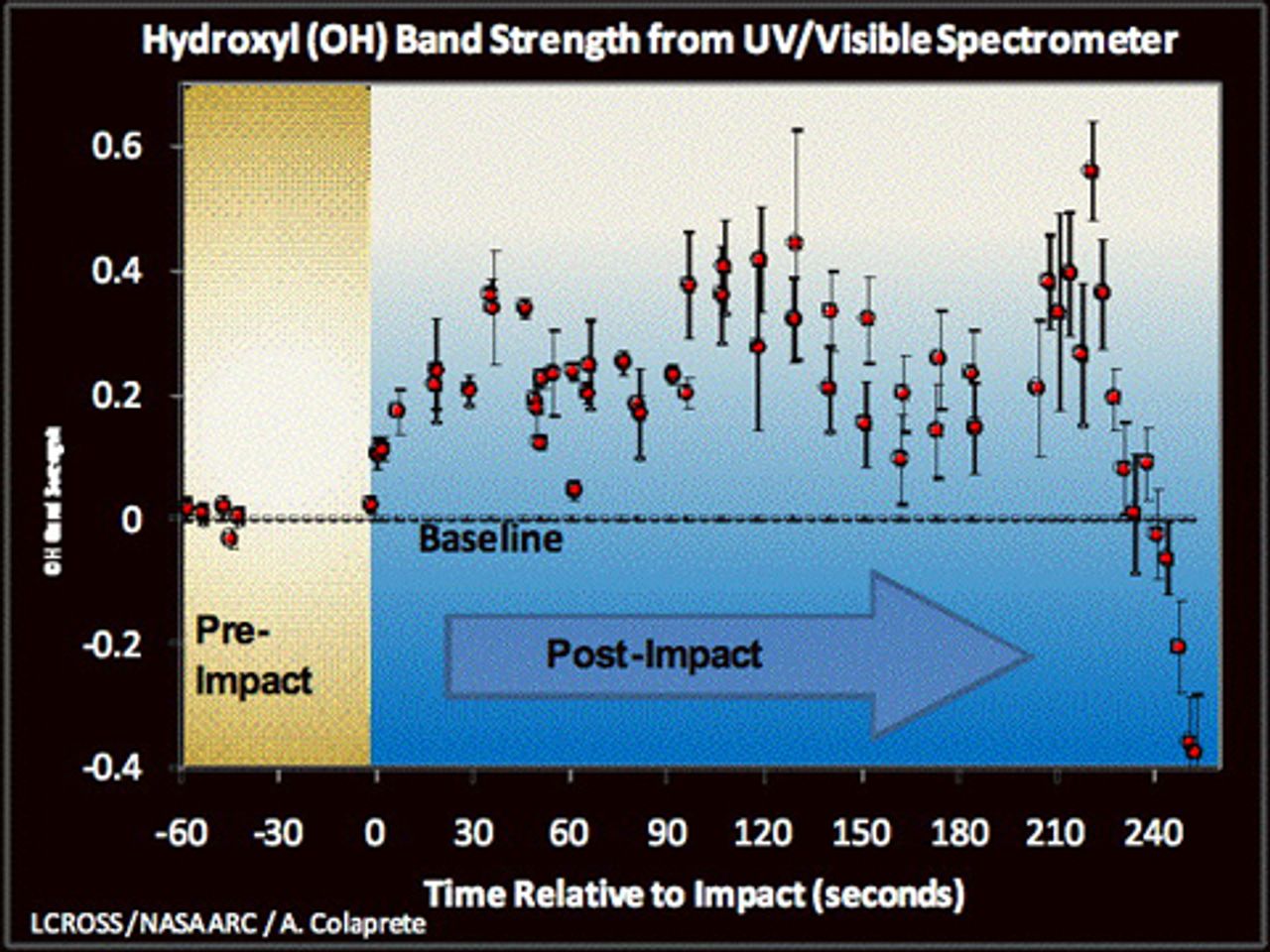The deliberate crashing of a US rocket into the surface of the Moon has produced evidence of “a significant amount” of water ice, a discovery that could revolutionize the exploration of the Earth’s satellite and even open the way to long-term settlement. The impact experiment, conducted on October 9, produced such an immense trove of data that it took more than a month for the first preliminary results to be compiled.
Jubilant scientists working on NASA’s Lunar Crater Observation and Sensing Satellite (LCROSS) told a press conference November 13 that the quantity of water detected in the debris of the collision far exceeded expectations. The crater produced by LCROSS striking the surface of the Moon at 5,600 miles per hour measured 60 to 100 feet wide and contained the equivalent of at least 26 gallons of water.
While that proportion of water to soil is far lower than the driest desert on Earth, it is much greater than previously believed, by as much as a factor of 100. Ice in such concentrations is potentially exploitable both to sustain human life as liquid water and to break down into its component parts—oxygen to breath, and hydrogen for fuel.
 Figure 1. LCROSS Visible Light Camera image of the lunar south pole from an altitude of approximately 770 km. Some south pole craters of interest are labeled. Credit: NASA
Figure 1. LCROSS Visible Light Camera image of the lunar south pole from an altitude of approximately 770 km. Some south pole craters of interest are labeled. Credit: NASAThe crater Cabeus, near the Moon’s south pole, was targeted for the experiment because of indications of the presence of hydrogen concentrations in the polar regions, followed by previous observations of water molecules by three separate spacecraft:
- The Moon Mineralogy Mapper (or M3), carried aboard the Chandrayaan-1 spacecraft, launched by the Indian Space Research Organization a year ago, which is now in lunar orbit.
- The Visual and Infrared Mapping Spectrometer, or VIMS, on NASA's Cassini spacecraft, which passed by the Moon in 1999.
- The High-Resolution Infrared Imaging Spectrometer on NASA’s Epoxi spacecraft, which passed the Moon in June on its way to a November 2010 rendezvous with the comet Hartley-2.
The quantities detected by these probes were much smaller than found by LCROSS, but helped to whet the interest of NASA scientists. These initial results were reported in the journal Science last month, in an article that suggested the presence of a thin film of water molecules over much of the Moon’s surface.
Cabeas, 60 miles wide and 2 miles deep, was considered a favorable location for the LCROSS experiment because the deep shade would trap water molecules permanently in the form of ice. The sun never shines into the bottom of the crater, and temperatures average minus 220 degrees Centigrade (minus 365 degrees Fahrenheit.)
The mission consisted of the LCROSS spacecraft mounted on a Centaur rocket. The pair did not separate after liftoff from the Earth, but continued linked into Moon orbit for a total of 113 days of travel, or 5.6 million miles. After separation, the empty Centaur rocket hit the crater first, and the observational platform, LCROSS, collected data on the explosive impact for four minutes before crashing into the Moon itself.
The presence of water ice was detected through the analysis of shifts in the color of light after the crash, showing the absorption of electromagnetic wavelengths specific either to the water molecule H2O or the hydroxyl molecule OH, a breakdown product of water after the explosion. Carbon dioxide, methane and other carbon-based molecules were also detected.
 Figure 2. Hydroxyl (OH) Band Strength. Explanation from NASA: “The OH emission lines strength plotted as a function of time. Before impact the line is flat (no OH). After impact the line strength grows and remains above the pre-impact baseline for several minutes.” Credit: NASA
Figure 2. Hydroxyl (OH) Band Strength. Explanation from NASA: “The OH emission lines strength plotted as a function of time. Before impact the line is flat (no OH). After impact the line strength grows and remains above the pre-impact baseline for several minutes.” Credit: NASAAnthony Colaprete, the chief scientist for the Lunar Crater Observation and Sensing Satellite mission, told the press conference, “The moon is alive… We are ecstatic.”
Colaprete explained the methodology of the experiment as follows: “Multiple lines of evidence show water was present in both the high angle vapor plume and the ejecta curtain created by the LCROSS Centaur impact. The concentration and distribution of water and other substances requires further analysis, but it is safe to say Cabeus holds water.”
The LCROSS research team compared the spectra collected by the LCROSS near infrared spectrometer of the impact. “We were only able to match the spectra from LCROSS data when we inserted the spectra for water,” said Colaprete. “No other reasonable combination of other compounds that we tried matched the observations. The possibility of contamination from the Centaur also was ruled out.”
The finding of significant amounts of water puts the question of Moon exploration into a new light. NASA’s current plan calls for a resumption of manned exploration by 2020, in the first manned mission since the last visit during the Apollo program in 1972. The new rocket to be used for that mission, the Ares, had its first preliminary trial earlier this month, but is years away from deployment. The panel appointed by the Obama administration to review NASA’s long-term trajectory concluded recently that budget cuts had made the 2020 goal impossible.
A revived and fully resourced Moon exploration program would cost only a tiny fraction of the amounts squandered on the Wall Street bailout or the wars in Iraq and Afghanistan. The entire NASA annual budget is less than the amount funneled into Citibank alone.
